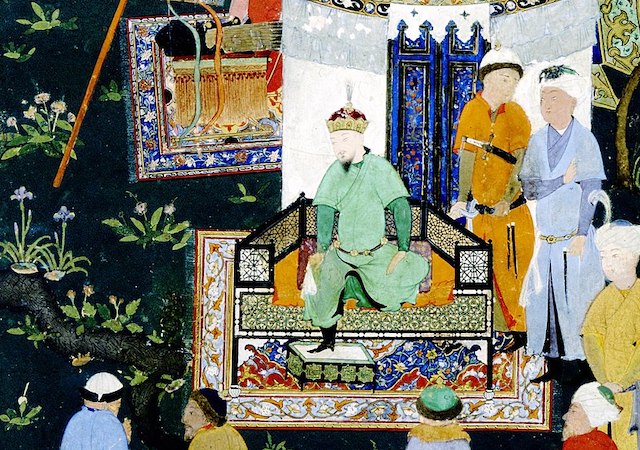Curses are as old as history, and some fervently believe in their power to create evil circumstances. The Bible is filled with them, both the Old Testament and the New. Even Jesus of Nazareth uttered a curse when he saw a fig tree that, to his disappointment, bore no figs. His curse ensured that no one would ever eat from that tree again.
Curses continue to affect people of all cultures, and there are as many ways to protect yourself from them as there are curses themselves. But some of them are nothing more than nonsense. Here are ten that have long been believed and quoted, although on closer examination they have little basis in fact.
10. The Curse of Tutankhamun

The Curse of Tutankhamun, like the Curse of the Pharaohs or the Curse of the Mummy before it, was largely a creation of a competitive media eager to sell newspapers. When Howard Carter's expedition discovered Tutankhamun's tomb in 1922, it caused a media frenzy. When Carter entered the tomb in late November, accompanied by George Herbert, Lord Carnarvon, who had financed the expedition, the frenzy reached a peak. More than 5,900 artifacts were eventually recovered from the tomb. They found no document or other item outlining the curse promising an early death to anyone who desecrated the tomb, although later events led the press to report that there were.
The following spring, Lord Carnarvon cut himself while shaving, reportedly nicking a mosquito bite that had already become infected. On April 5, 1923, Lord Carnarvon died of septicaemia caused by the infected wound, and although he had been ill for more than two decades, the media seized on the curse of Tutankhamun. Several other deaths among excavators followed, but according to the British Medical Journal The Lancet , their frequency did not exceed the norm for a population sample of similar size. Howard Carter lived another 16 years and died at the age of 64 of natural causes.
The Curse of Tutankhamun is based on and expanded on stories of curses placed by ancients to protect their final resting places and the objects they took with them on their journey to another world. After being excavated, Tutankhamun's mummy and many of the objects recovered from his tomb traveled around the world. Whenever the artifacts reached a new destination, the media faithfully reproduced the legend of Tutankhamun's curse, exciting their audiences with threats of doom. But there is little evidence to support the curse ever existing, and even less evidence that the curse was found in writing by Carter and his team.
9. The Curse of Tippecanoe

Tippecanoe refers to William Henry Harrison, the American general who led the forces that defeated Tecumseh's forces at the Battle of Tippecanoe in 1811, temporarily ending the power of Tecumseh's Confederacy. According to legend, Tecumseh's brother Tenskwatawa was to blame for the Indian's defeat, and in response, he placed a curse on the presidency, although it would be another 29 years before Harrison was elected president. Others argue that the Shawnee leader had nothing to do with the supposed curse on the American presidency. It became known as the Curse of Tippecanoe because Harrison, a hero of Tippecanoe, was elected president in 1840, the year it began.
According to the curse, every American president elected to office in a year ending in zero will not live to see out their term. Harrison was the first American president to die in office, in 1841. The next president elected to a fixed term, Abraham Lincoln, died in office but after being inaugurated for a second term in 1865. In 1880, James Garfield was elected but was assassinated in his first term. In 1900, the same thing happened to William McKinley. In 1920, Warren Harding was elected but died of heart problems during his first term. In 1940, Roosevelt was elected (his third term), and although he died in office, it was his fourth term, serving 12 years and one month as president.
1960, and the election of John F. Kennedy, was the last time the “curse” occurred, when JFK was assassinated in his third year in office. Since then, it has spared Ronald Reagan (1980), George W. Bush (2000), and, as of this writing, Joe Biden (2020). The curse is mentioned in the media every 20 years or so, but in truth, it has little power beyond entertainment value. More interestingly coincidental than cursed, the Curse of Tippecanoe is a strange quirk of American history.
8. The Curse of Rosemary's Baby

For the uninitiated "Rosemary's Baby" — a 1968 American psychological thriller film directed by Roman Polanski. It stars Mia Farrow in a role in which she suspects her neighbors are members of a Satanic cult and covets her unborn child for use in rituals. Polanski originally wanted his then-fiancée Sharon Tate to play the lead role, but ultimately decided that at that stage in her career, she did not have the star power to carry the vehicle. However, Tate became a victim of the so-called curse that afflicted the film and some of its players and workers, at least according to some.
Proponents of the curse include the famous Dakota building in New York City, which was used in the filming and the site of John Lennon's murder 12 years later. Tate was murdered by the Manson family, while Polanski fled to France and emigrated after being held for 42 days on felony drug charges and child rape. Composer Christophe Komeda, who wrote the film's soundtrack, died after falling off a cliff while intoxicated.
The film's producer, Robert Evans (who also produced The Godfather), got into trouble for cocaine trafficking and earned himself probation in exchange for posting anti-drug public service announcements. So while bad things happened to some of the people involved in the making of the film, it was unlikely to be supernaturally caused, and the two main stars, Mia Farrow and John Cassavetes, appear to have escaped unscathed.
7. The Curse of Macbeth

According to theatrical lore, to utter the name Macbeth or to read or quote a line from the play in a theatre where the play is not currently being performed is to place a curse on the offender and all those present. One source of the curse was Shakespeare's use of the three witches and their spells in the play. The curse was placed on the play because the Bard used a real spell in his script, apparently an oversight among witches and non-witches. At least according to the Royal Shakespeare Company, the curse has affected the play since its first performance around 1606.
Chris Rock famously walked onto the stage during the 2023 Oscars only to be slapped by Will Smith after Rock made comments that were considered derogatory towards Smith's wife. What's less well known is that just minutes before, Rock congratulated Denzel Washington on his performance in "The Tragedies of Macbeth" while saying the forbidden word. So perhaps the curse led to a viral moment that stunned the audience and caused a surge in Twitter activity.
There’s really no way to disprove this curse, because there’s nothing to disprove. Witches do appear in Macbeth (“Bubble, bubble, toil and trouble…”), and whether they’re casting a real spell is something only their fellow witches know. The play has a long history of questionable, violent, and even fatal events occurring in many of its productions, including films. Perhaps the best way to disprove the curse is to experiment. Next time you’re at the theater, just say the name Macbeth out loud and wait for things to happen. Good luck.
6. The Curse of the Bermuda Triangle

A writer named Vincent Gaddis coined the term "Bermuda Triangle" in a 1964 article published in Argosy Magazine. Later writers picked up the mantle, describing the triangle's boundaries, changing them when necessary to suit their thesis. By the 1970s, the triangle was the subject of paperbacks, documentaries, fiction, and other forms of entertainment, both written and filmed. The truth is that the Bermuda Triangle is no more prone to strange phenomena and disappearances than any other similarly sized ocean area in the world. It just had better publicity.
The U.S. Coast Guard does not officially recognize the Bermuda Triangle, though that does not stop breathless media coverage of Coast Guard searches inside the triangle when circumstances warrant it. The headlines simply draw more attention to the words “Bermuda Triangle.” One of the most famous events inside the triangle, the loss of U.S. Navy Flight 19, continues to figure in triangle lore as the unexplained clear-weather disappearance of highly trained Navy pilots during a simulated bombing run. In fact, although the flight began in clear weather, by the time the pilots radioed in that they were lost, the weather had deteriorated significantly, and the Navy has long attributed the loss of the flight to pilot error on the part of the flight commander.
The Bermuda Triangle is a classic example of an urban myth created by false reports, circulars, deliberate lies, and sensationalism. This is not to say that there have not been losses of ships and planes within the region’s loosely defined and flexible boundaries. Ships, boats, and planes disappear at sea in all waters of the world almost every day, and many of them leave no explanation for what happened. But this has not happened in the Bermuda Triangle any more than anywhere else, especially given the heavy traffic in the area, much of it driven by untrained recreational boaters.
5. The Curse of King Casimir IV

Fifty years after the discovery of Tutankhamun's tomb in Egypt, another group of archaeologists and excavators planned to open the tomb of the Polish king Casimir IV. Casimir IV reigned in the 15th century and his reign was described as "successful and peaceful," although he achieved relatively little during his time on the throne (1447–1492).
Following the heavily media-watched opening of the tomb, several participants in the excavation developed lung diseases. This led to media speculation about a curse, reminiscent of the media frenzy over the curse of Tutankhamun half a century earlier. According to some sources, at least fifteen members of the archaeological team that entered the tomb died of mysterious, unexplained lung diseases, and the curse of King Casimir surpassed that of Tutankhamun.
It turned out that the tombs of the two kings had a common denominator, but it wasn’t a curse. At least, not a supernatural curse. It was the fungus Aspergillus Flavus, found in both tombs. The fungus caused a condition known as aspergillosis, especially in people with already compromised lungs or immune systems. Additional fungi were also identified that contributed to the illnesses of those who entered Casimir’s tomb. Casimir IV’s “curse” was unknown to science, not supernatural activity.
4. The Curse of Tamerlane

Soviet dictator Joseph Stalin was an admirer of the Mongol leader and warlord Tamerlane, also known as Timur. Timur was the first ruler of the Timurid dynasty in the late 14th and early 15th centuries. After his death, he was buried in a mausoleum known as Gur-e Amir in modern-day Uzbekistan. In 1941, Uzbekistan was a Soviet Socialist Republic subject to the whims of Stalin, who ordered the mausoleum opened in 1941, ostensibly to verify that it contained the bodies of Tamerlane, his sons, and other relatives. Stalin assigned the task to renowned Soviet anthropologist Mikhail Gerasimov.
Gerasimov opened the crypt containing Timur's remains in the presence of local authorities on June 20, 1941, despite warnings carved into the mausoleum walls against desecrating the grave. Local authorities also warned against it. On June 22, 1941, Nazi Germany invaded the Soviet Union, the first steps in a war that would kill millions. For many, the curse of Tamerlane led to the carnage that befell the Soviet republics and the rest of Eastern Europe, as well as Germany.
Those who link the Eastern Front to the Curse of Tamerlane ignore the fact that the German High Command began planning what became known as Operation Barbarossa in the early summer of 1940, after the fall of France. Hitler pushed Germany to invade by the end of 1940, six months before the Soviet excavators opened Tamerlane’s tomb. So the Curse of Tamerlane certainly did not cause the catastrophe that befell Eastern Europe in the summer of 1941, as many have attested over the years.
3. The Curse of Superman

Many actors have played the Man of Steel on television and in feature films. The events of two of them should give pause to others considering the role, at least those who believe in the Curse of Superman. It all starts with actor George Reeves , whose film career got off to a promising start when he appeared opposite Vivien Leigh in the opening scenes of Gone with the Wind, playing one of the Tarleton twins. By the 1950s, Reeves had achieved success and recognition thanks to his role as Superman. However, he found himself in this role and looked for ways to escape into others. Unfortunately, his filming schedule did not allow him to accept other roles. Reeves died of a self-inflicted gunshot wound in 1959, although some question whether it was truly suicide.
The next major actor to suffer from the so-called curse was Christopher Reeve (no relation), who played Superman/Clark Kent in four films in the 1970s and 1980s. Reeve was in a horse-riding accident in 1995, paralyzing him from the neck down and confining him to a wheelchair for the rest of his life. He died in 2004 at the age of 52. Others cited as being affected by the curse include Margot Kidder, who played Lois Lane in the Christopher Reeve films. In 2002, she told the Daily Telegraph that the curse was "a bunch of newspaper nonsense." Proponents of the curse believe it goes much deeper, even affecting Superman's creators, Joe Shuster and Jerry Siegel.
Despite the urban legend of the curse, it appears to have been limited to just the two actors who actually portrayed the Man of Steel. Others, including Dean Cain, Henry Cavill, Brandon Routh, and Tom Welling, have so far been apparently exempt from the curse. Actors before George Reeves, including Bud Collyer, who voiced Superman on radio, and Kirk Alyn, who played him in TV series in the 1940s, have also escaped the curse. But Lee Quigley, who appeared as the baby who became Superman in Christopher Reeve's 1978 film, died of solvent abuse in 1991, when he was just 14 years old.
2. The Curse of My Path

One wonders what Sinatra would think of one of his most popular songs being cursed to bring death to those who dare sing it in public. But such is the case in the Philippines, where local legend describes the Curse of My Way. According to the curse, since about 2002, performers of the song in karaoke bars (called videokes in the Philippines) have been shot to death, and there have been several other incidents of violence. Often these are caused by off-key singing, repetitive singing, and in some cases, sheer premeditation. At least one security guard shot and killed a singer after he failed to heed a warning to stop singing the song.
The exact number of murders attributed to the My Way Curse varies depending on the source. At least one was the deliberate murder of a barangay (roughly a barrio chairman) who chose to sing the song at a Christmas party. Although there have been cases of karaoke violence caused by other songs in other countries, the My Way Curse appears to be localized to the Philippines, and has lasted for over 20 years. In the 2010s, several of the thousands of karaoke bars in the Philippines removed the song from their repertoire, but sporadic killings have continued since then.
There are several possible explanations for why Sinatra’s classic, written by Paul Anka, may have been the catalyst for violence. First, there’s the hubris of the lyrics themselves, delivered as the singer stands before the “final curtain.” Sinatra’s version has been called “America’s anthem of self-determination.” But the curse doesn’t seem to have hurt Frank, who released his own version of the song in 1969. And there’s nothing mysterious or supernatural about the murders, mostly linked by a disgruntled listener and alcohol. The My Way Killings are more of a social phenomenon than a curse, along with karaoke-related violence in much of the so-called civilized world.
1. The Conqueror's Curse

Of the approximately 220 people who worked on John Wayne's 1956 car,Conqueror" in the Utah desert, 91 developed some form of cancer, and of those 46 died from the cancer or its complications. Among them were Wayne, co-star Susan Hayward, Agnes Moorehead, Lee Van Cleef, director Dick Powell, and several others, most of them in the 1960s and early 1970s. This led to the belief that the film, in which Wayne played Temujin, better known as Genghis Khan, was cursed. Most of the film's exterior scenes were shot in Escalante, a desert area about 135 miles downwind from the site of the U.S. government's 1953 Operation Upshot-Knothole nuclear weapons tests.
In 1980, a University of Utah biology professor called the high cancer rates and subsequent deaths from the production an “epidemic.” It led to “The Conqueror’s Curse,” in which those working on the film were doomed to fail. But the numbers don’t add up. Statistically, the odds of American men getting cancer are about 40.2%, and the odds of dying are about 20.5%, which is very close to the rates the crew suffered. Conqueror In 1956, the odds were higher, treatment was less advanced, and many of the victims were heavy smokers, including Wayne, Hayward, and Van Cleef (a notable exception was Agnes Moorehead, a teetotaler and non-smoker who developed fatal uterine cancer).
The deaths gave the film its reputation, causing its producer Howard Hughes to buy almost every available print, effectively banning it from distribution for years. Critics were not particularly kind, even before the film's surrounding "The Grudge." In 2013, The Guardian re-watched the film, saying little about it. There is still debate about whether radiation exposure contributed to the crew's illnesses and deaths. But few argue about the quality of the film, which is generally considered one of John Wayne's worst.













Оставить Комментарий